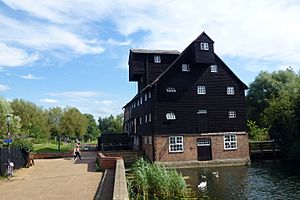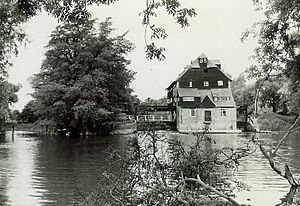Houghton Mill facts for kids
Houghton Mill is a historic water mill found in the village of Houghton, Cambridgeshire, England. It sits right on the Great Ouse river. This special building is owned by the National Trust, a charity that protects important places. It's also a Grade II* listed building, which means it's a very important historical site.
Contents
The Mill's Long History
People have known about a mill here since the year 974. That's over a thousand years ago! For a long time, the mill belonged to Ramsey Abbey, a large monastery nearby.
Early Days and Challenges
The people who lived on the abbey's land had to bring their wheat to this mill. The miller would grind their wheat into flour. As payment, the miller would keep some of the flour.
Around the year 1500, the Abbot (the head of the abbey) changed the river's path. He wanted to make sure the mill had enough water power. But this change caused the nearby village to flood. The villagers were very upset and protested. Fifteen years later, they were allowed to change the water's course themselves if there was an emergency.
Changes in Ownership
Later, during a time called the Dissolution of the Monasteries, the King took control of many abbey lands. The mill then became the property of the Crown. The current mill building replaced an older one that burned down in the 1600s.
A Famous Miller
One of the most well-known millers was Potto Brown (1797–1871). He was a very religious man. He was so devoted that he even brought his business ledgers to family prayer meetings. He would talk to God about the money people owed him. After he passed away, a bronze statue of him was put up in Houghton.
The Present Houghton Mill
While a mill has been on this site for a long time, the very first mill was actually a bit further along the river. That original mill pond is still there today. It now looks like a natural part of the river.
Building and Design
The building you see today was probably built in the 1600s. It was made bigger in the 1800s. It has three main floors and extra space in the attic. The building is made partly of brick and partly of wood. Some parts are covered with wooden boards called weather-boarding.
From Hostel to Tourist Spot
In the 1930s, the mill stopped working as a flour mill. Local people bought the building to save it. They then gave it to the National Trust. From 1935 to 1983, Houghton Mill was used as a youth hostel. It was a place where young travelers could stay. It was one of the few hostels where smoking was not allowed because of the risk of fire.
Milling Today
In 1999, the National Trust put in new millstones. Today, flour is still made at Houghton Mill. It is now a popular place for visitors. There is also a camping site nearby.
Houghton Mill is the last working watermill on the Great Ouse river. A traditional waterwheel helps the mill make stoneground flour. If the river water levels are too low, the mill uses special electric-powered millstones instead. The wheat used here comes from the National Trust's Wimpole Estate, which is about 19 miles (30 km) away. In 2013, new electric millstones were added. This allows the mill to keep working even when the river isn't high enough.
See also
- Christopher Biden



